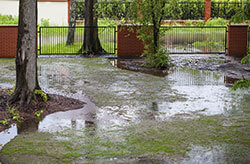How Too Much Rain Affects Your Lawn
May of 2015 brought the second-highest rainfall totals every recorded in Wichita. While Kansas and other parts of the Midwest needed the relief from the drought experienced in recent years, there can be too much of a good thing. For many homeowners, soggy lawns could turn into big problems.
Lawn Problems Caused by Excessive Rain and Over Watering
Surface damage – Walking and moving objects like trash cans across a saturated lawn will not only compact Wichita’s clay soils, but it can leave permanent marks or tracks in your yard.
Drown grass roots – Grass needs oxygen to grow, and excessive water will fill the air gaps in the soil, effectively drowning the plants.
Disease caused by fungus – Too much water can cause grass roots to rot and can lead to disease which starts off as yellow patches in your yard; once fungus sets in, little can be done except reseeding the dead patches in the fall.
Shallow root growth – Grass roots that don’t have to go far below the surface to find water can’t withstand drier conditions, leading to dead brown patches.
Prone to disease and insects – When your lawn has a shallow root system, the grass becomes stressed, making it more susceptible to damage from insects and disease.
More weeds – Consistently overwatering your lawn can cause a lot of hard-to-kill weeds to grow
Loss of nutrients – If your lawn gets too much water, vital nutrients are washed away before they can be absorbed through the root system.
Excessive fertilizer needs – Because your grass isn’t getting the nutrients it needs, you’ll have to use additional fertilizer to try and compensate.
Waste money and water – Your lawn can absorb a limited amount of water at a time, so over watering or watering your lawn when it’s raining causes you to pay for and use water the grass doesn’t need; and, as mentioned above, you’ll be spending more money on costly fertilizer treatments
Add to groundwater pollution – Any excess water applied to a yard runs off into the wastewater system, carrying surface pollutants such as pet waste, fertilizers, and other lawn maintenance chemicals.
Prevent Over Watering Problems
Of course, you can’t control the rain, but you can take steps to help your lawn get through periods of both rain and drought.
Make sure your yard has proper drainage
After a
rain storm, check your yard for puddles or standing water. If there are
low spots in your yard, bringing in some fill dirt and reseeding the
area can help. Also, make sure your rain gutters are clean and that the
downspouts have extenders on them to direct water away from your home’s
foundation. You can even install extenders that can be buried to form a
french drain system that disperses the water underground instead of on
your lawn’s surface.
Know when and how much to water your lawn
Basically,
your yard should be watered deeply but infrequently. Here in Wichita,
most lawns only need about an inch of water per week, and watering every
day usually isn’t necessary. Letting the soil dry out between watering
will encourage deep root growth and thick grass coverage, which means
your lawn will withstand drought conditions better. You’ll need to
adjust your watering plan throughout the season as your lawn’s water
needs change.
If you have a sprinkler system, consider installing a rain sensor
Kansas storms can pop up with little warning, but adding a rain sensor to your irrigation system
controls will prevent the sprinklers from running when it’s raining. In
addition to keeping your lawn healthy, you’ll save money and conserve
water.
Need help setting up a watering plan or dealing with the effects of too much rain on your lawn? Call the professionals at Reddi Lawn Care today at 316-858-0736.
Resources found on our website are provided as general guidelines, and Reddi Industries does not assume any liability resulting from the provided information.

